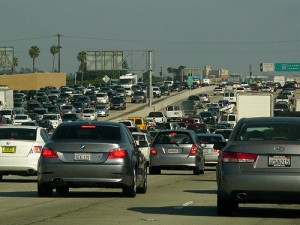L.A.'s Carmageddon: Would Building a Train Be Smarter Than Widening the 405?
 Photo: sontag1
Photo: sontag1The “mother of all traffic jams,” in the words of L.A. County supervisor Zev Yaroslavsky, is coming to Los Angeles. On the weekend of July 16/17, an 11-mile segment of Interstate 405 will be closed as part of a $1 billion widening project. Reading of the expected traffic jams, and having recently returned from western Europe, where I traveled mostly by train, I was reminded of an earlier traffic nightmare.
This example I learned from Robert Caro’s 1974 masterpiece The Power Broker: Robert Moses and the Fall of New York. Robert Moses was New York City’s “master builder” in the mid-20th century, and famously hated public transportation. When he was in charge of building the Van Wyck Expressway to the new Idlewild airport (now JFK), F. Dodd McHugh, chief of the Office of Master Planning of the City Planning Commission, argued that a train line be part of the plans. Or at least, he suggested, when taking the land by eminent domain to build the expressway, why not take an extra 50 feet of width? The land would still be cheap, before the existence of the road increased population density and property prices, and the extra width could be reserved to build a train later. Moses vetoed these ideas.
Let’s see who was right by using my favorite street-fighting tool for mastering the numbers around us: comparing apples to apples. Here the apple is capacity; the comparison is the capacity of a highway to the capacity of a train line.
I’ll first estimate the carrying capacity of one lane of highway; it is the number of passengers who pass by during a fixed time (usually 1 hour). For this estimate, a lesson from driver-education classes is helpful. Driving courses teach, and many drivers-license exams test, the 2-second following rule:
Each car should leave a distance between it and the next car equal to 2 seconds of travel time.
If the drivers follow this rule, a single lane of highway carries one car every 2 seconds (no matter how fast the traffic is flowing!). Each car carries roughly 1 person, making for a flow of 1 person every 2 seconds. With 3600 seconds in 1 hour, a single lane of highway carries:
1 person 3600 seconds 1800 people
——— * ———— = ———–
2 seconds 1 hour hour
These figures are all rough anyway, so let’s call it 2000 people per hour. This estimate is one apple in the comparison.
The other apple is the carrying capacity of a train line. To make a fair comparison, I’ll compare highly developed roads to a highly developed train system: say a French, Swiss, or German train. (About the American train system, my mother taught me that if you cannot say something nice, don’t say anything.)
One train car may hold about 150 people. The whole train may contain 20 cars. And on a busy train route, one train might run every 5 minutes or 12 times per hour. Therefore the capacity of the train line is estimated with the following product:
150 people 20 cars 12 trains 36,000 people
———– * ——- * ——— = ————-
train car train hour hour
These figures are also rough, so let’s call it 40,000 people per hour. (Even though the individual factors are highly variable, the final estimate is reasonable. According to the figures at this commuting blog, one track of the highly optimized Parisian commuter-rail system, the RER, can carry 55,000 passengers per hour. And Caro himself quotes “40,000 persons per hour” for a single lane of rapid transit.)
This capacity is 20 times the capacity of a highway lane! Even allowing that a train track could be wider than a highway lane, one train line could replace an entire highway, even a highway with five lanes in each direction (such as L.A.’s Interstate 405).
In theory, therefore, Robert Moses was wrong and city planner F. Dodd McHugh was right. And in practice, the city planner was also right. Not long after the Van Wyck Expressway opened in 1950, when air travel was much less widespread than today, the airport traffic alone exceeded 10,000 vehicles per hour– the official peak capacity of the whole highway. Anyone who lives in New York City will confirm that the situation has only gotten worse in the intervening decades. An original train line would have made the journey faster and more pleasant for so many New York residents and visitors. It would have also been easier (and cheaper) to build than the $1.9 billion AirTrain monorail completed in 2003.
The cost of building the original train line (3 miles of surface rapid transit) was estimated at $9 million in 1950 dollars. Let’s call the $9 million then a rough $200 million today. Multiply that by 2.7, since at 8.1 miles, the AirTrain is 2.7 times as long as the original line. And you still don’t come close to reaching AirTrain’s $1.9 billion price tag.
In a bitter twist, L.A.’s project of widening Interstate 405 includes building a carpool or HOV (high-occupancy-vehicle) lane. What the estimates above show, and the sad experience of driving to JFK airport confirms, is that the highest-occupancy vehicle is a train. If Los Angeles had learned the lesson, Angelenos today would not have to worry about Carmageddon.

Comments